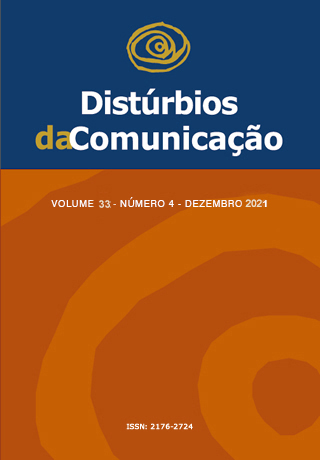Eficácia de terapia de fala em grupo para pacientes com a doença de Machado Joseph
uma série de casos
DOI:
https://doi.org/10.23925/2176-2724.2021v33i4p659-665Palavras-chave:
Doença de Machado Joseph, Disartria, Reabilitação, FonoaudiologiaResumo
Objetivo: Verificar o benefício de terapia fonoaudiológica em grupo na inteligibilidade de fala de pacientes com Doença de Machado Joseph (DMJ). Método: Realizou-se uma série de casos, com pacientes atendidos em um ambulatório de fonoaudiologia para adultos neurodegenerativos em um hospital de referência no sul do Brasil. Foram incluídos pacientes com o diagnóstico molecular de DMJ. Realizaram-se coletas de fala pré e pós-intervenção. Posteriormente, os trechos de fala passaram por análise perceptiva-auditiva por 3 fonoaudiólogas treinadas e calibradas a um índice Kappa ≥ 0.90, cegas às coletas de fala e por análise acústica no software Praat. A terapia fonoaudiológica foi realizada em grupo, composta por quatro sessões semanais de cinquenta minutos. Cada sessão foi dividida entre exercícios de fala e orientação sobre estratégias para otimizar a comunicação. Resultados: A amostra foi composta por 5 pacientes com média de idade de 39,8 anos (±16,51) e tempo de doença de 10 anos (±8,15). Quatro (80%) participantes receberam diagnóstico fonoaudiológico inicial de disartria leve e um (20%) de disartria moderada. Após a intervenção, não houve melhora no diagnóstico de disartria, contudo verificou-se que 60% (n=3) dos participantes apresentaram melhora na articulação, 40% (n=2) na prosódia e ressonância e 40% (n=2) apresentaram piora na respiração. Na análise acústica observou-se melhora no tempo máximo de fonação (TMF) em 3 (60%) dos 5 pacientes. Conclusão: Verificou-se melhora na funcionalidade da fala através da análise perceptiva auditiva, porém com pouca melhora em parâmetros específicos da análise acústica.
Downloads
Referências
Li T, Martins S, Peng Y, Wang P, Hou X, Chen Z, Wang C, Tang Z, Qiu R, Chen C, Hu Z, Xia K, Tang B, Sequeiros J, Jiang H. Is the High Frequency of Machado-Joseph Disease in China Due to New Mutational Origins? Front Genet. 2019;20(9):1-8 doi: 10.3389/fgene.2018.00740.
de Castilhos RM, Furtado GV, Gheno TC, Schaeffer P, Russo A, Barsottini O, Pedroso JL, Salarini DZ, Vargas FR, de Lima MA, Godeiro C, Santana-da-Silva LC, Toralles MB, Santos S, van der Linden H Jr, Wanderley HY, de Medeiros PF, Pereira ET, Ribeiro E, Saraiva-Pereira ML, Jardim LB; Rede Neurogenetica. Spinocerebellar ataxias in Brazil-frequencies and modulating effects of related genes. Cerebellum. 2014;13(1):17-28. doi: 10.1007/s12311-013-0510-y.
Prestes PR, Saraiva-Pereira ML, Silveira I, Sequeiros J, Jardim LB. Machado-Joseph disease enhances genetic fitness: a comparison between affected and unaffected women and between MJD and the general population. Ann Hum Genet. 2008; 72(1):57-64. doi: 10.1111/j.1469-1809.2007.00388.x.
Coutinho P, Ruano L, Loureiro JL, Cruz VT, Barros J, Tuna A, Barbot C, Guimarães J, Alonso I, Silveira I, Sequeiros J, Marques Neves J, Serrano P, Silva MC.Hereditary ataxia and spastic paraplegia in Portugal: a population-based prevalence study. JAMA Neurol. 2013; 70(6): 746-55. doi: 10.1001/jamaneurol.2013.1707.
Martins S, Sequeiros J. Origins and Spread of Machado-Joseph Disease Ancestral Mutations Events. Adv Exp Med Biol. 2018; 1049: 243-54. doi: 10.1007/978-3-319-71779-1_12.
Bettencourt C, Lima M. Machado-Joseph Disease: from first descriptions to new perspectives. Orphanet J Rare Dis. 2011;2(6):1-12. doi: 10.1186/1750-1172-6-35.
Wolf AE, Mourão L, França Jr MC, Machado Júnior AJ, Crespo A/N. Fonoarticulação em ataxia espinocerebelar tipo 3. Eur Arch Otorhinolaryngol. 2017;274(2):1139-45. doi: 10.1007/s00405-016-4240-x.
Klockgether T, Mariotti C, Paulson HL. Spinocerebellar ataxia, Nat Rev Dis Primers. 2019;5(1). doi: 10.1038/s41572-019-0074-3.
Marques TS, Furia CLB, Lira JO. Atuação fonoaudiológica na doença de Machado-Joseph: relato de caso. Audiol Commun Res. 2020; 25(4): 1-8. doi: 10.1590/2317-6431-2019-2264.
Busanello AR, Castro SAFN, Rosa AAA. Disartria e doença de Machado-Joseph: relato de caso. Rev. soc. bras. fonoaudiol. 2007; 12(3): 247-51. doi: 10.1590/S1516-80342007000300013.
Vogel AP, Stoll LH, Oettinger A, Rommel N, Krays EM, Timmann D, et al. Speech treatment improves dysarthria in multisystemic ataxia: a rater-blinded, controlled pilot-study in ARSACS. J Neurol. 2019; 266(5): 1260-6. doi: 10.1007/s00415-019-09258-4.
Boersma an Weenick. Boersma P, Weenink D. Praat: Doing Phonetics By Computer. 2009.
Behlau M. Voz: O Livro do Especialista. 2ª ed. Rio de Janeiro: Revinter, 2001.
Souza APR, Crestani AH, Vieira CR, Machado FCM, Pereira LL. O grupo na fonoaudiologia: origens clínicas e na saúde coletiva. Rev. CEFAC. 2011; 13(1): 140-51. doi: 10.1590/S1516-18462010005000042.
Araújo MLB, Freire RMAC. Atendimento fonoaudiológico em grupo. Rev. CEFAC. 2011; 13(2):362-8. doi: 10.1590/S1516-18462011000200019.
Ribeiro VV, Panhoca I, Dassie-Leite AP, Bagarollo MF. Grupo terapêutico em fonoaudiologia: revisão de literatura. Rev CEFAC. 2012; 14(3): 544-52. doi: 10.1590/S1516-18462011005000131.
Miranda CS, Soares ECS, Ortiz KZ. Eficácia do processo terapêutico fonoaudiológico em grupo para disartria. Fono Atual. 2005; 8(32): 32-9.
Downloads
Publicado
Edição
Seção
Licença
Copyright (c) 2021 Bruna Graciele Souza Alós, Renelle Chaya Millette, Annelise Ayres, Rafaela Soares Rech, Maira Rozenfeld Olchik

Este trabalho está licenciado sob uma licença Creative Commons Attribution 4.0 International License.









